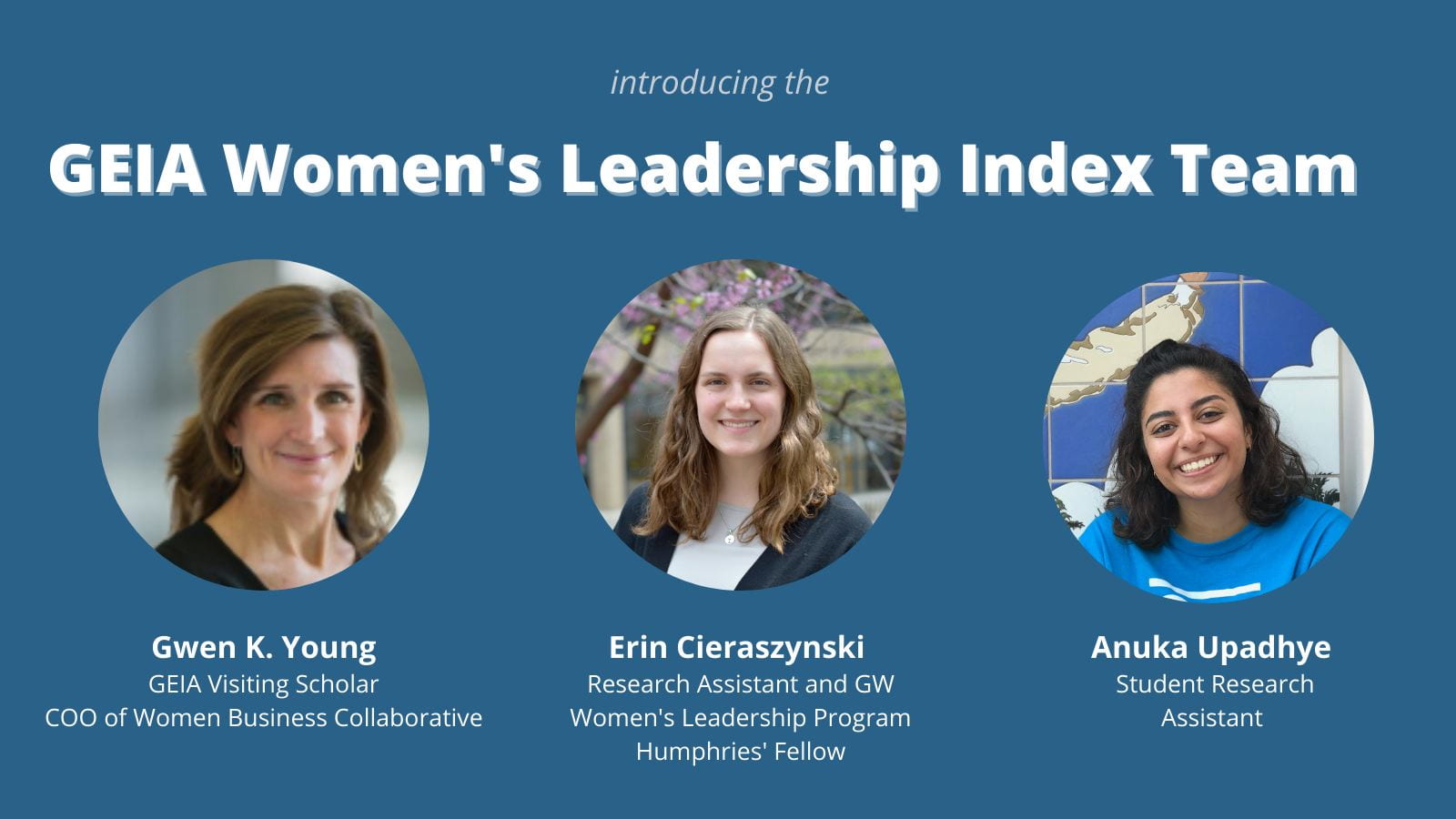Erin Cieraszynski, Research Assistant and Fellow
On April 14th, 2021, the Gender Equality Initiative in International Affairs (GEIA) proudly hosted the official launch of the GEIA Women’s Leadership Index at the Elliott School of International Affairs. This project has been in progress for over a year, led by visiting scholar Gwen Young and with support from student research assistants Erin Cieraszynski and Anuka Upadhye. At this event, aptly titled Women Leading Globally: Tracking Representation and Power in 2021 — Gwen Young and GEIA Director Shirley Graham discussed why this data is crucial with particular focus on women in national security.
The main question of the event was “why data?” In conclusion, the index is solutions oriented. It exists to measure, see change, and understand which levers need to be pushed to enact gender oriented policies. It helps us understand which strings of society we need to pull to change the way women are treated. Young explained simply that “we need to be able to measure where we are in order to get to where we want to be.”
More deeply, the index shows the relationship between different indicators and how they are all related. The 80 plus indicators spanning 75 countries cover 5 sectors of government, but mostly make up 3 categories: Pathways, Position, and Power. Pathways define how one gets into leadership — through education, equality clauses in the constitution, access to jobs, etc. Position outlines what the leadership positions are and if women occupy them. Power analyzes whether women can influence agenda setting and the extent to which their position allows them to make decisions over key institutions, such as budget control, and if they have veto power or control over the rule of law. While the compilation of these indicators paints a picture of each country, the index does not rank them from “best” to “worst.” Instead, the index categorizes each country into one of four sectors: balanced parity, siloed parity, flat parity, pursuing parity. By doing this, the index effectively is able to compare and contrast each country as it stands and demands parity across the board, not just those in the lowest tier. For example, the United States is parallel to Nigeria and South Korea in the flat parity section.
In looking at the indicators and country’s statuses, it is obvious that there are a few key takeaways. The first is that education matters — not just formal education — but informal training and trade schools as well. The second finds that part time work enables more women to lead, as many women are in part time positions for most of their career. With options such as subsidized childcare and improved education, this part time work becomes more viable. The third takeaway determines that public administration is the closest sector to parity than anywhere else, but only in certain topics. More women are needed in the finance, defense, and infrastructure fields. The final takeaway is that perception matters — meaning how the media portrays women and how people talk about women’s issues in the country. This changes the vision of what good and expected leadership looks like. Overall, women are linked to good governance and should be in decision making positions to improve the overall health of a country’s institutions.
Within national security these numbers are especially important as women are severely underrepresented in this sector. However due to strict security and confidentiality rules, this data is not the easiest to obtain. In general, the link between women in leadership positions and levels of violence are inextricably linked. The more gender equal a country, the more stable, secure and prosperous it is, therefore, when there are more women in positions of power a country is more likely to be peaceful. Women need to be not only at the table, but also need to be the ones signing peace treaties, advocating for negotiations, and participating actively in resolution processes.
There are many steps to move forward with this index and gaps to fill. It is a consistently evolving framework which always has room for improvement. For example, it needs to expand to covering more than 75 countries and will benefit from new data about the judicial branch and workforce numbers related to the COVID-19 pandemic. These gaps create many opportunities for faculty and student engagement alike, and we are glad the index has the support from the Elliott School to allow it room to continue to grow and improve.
The event concluded with a special appearance from the Dean of the Elliott School of International Affairs, Dr. Alyssa Ayres. With the Dean’s encouraging comments of support, it is obvious that the GEIA Women’s Leadership index is just getting started at its new home and will have a positive impact on the community for years to come.

